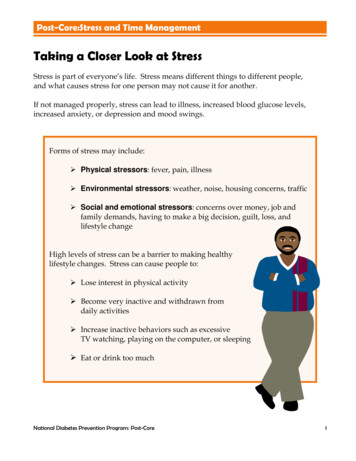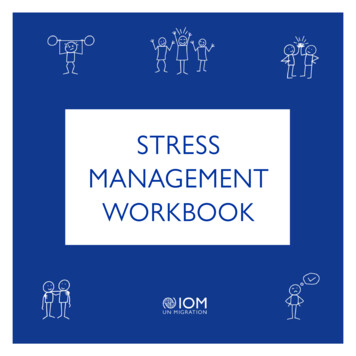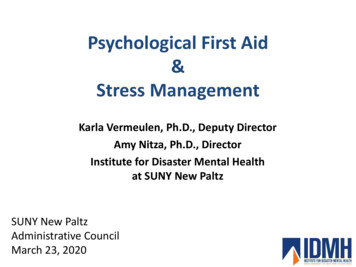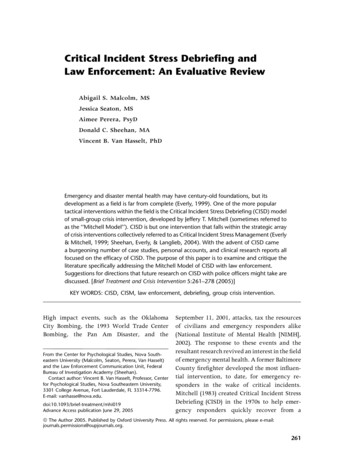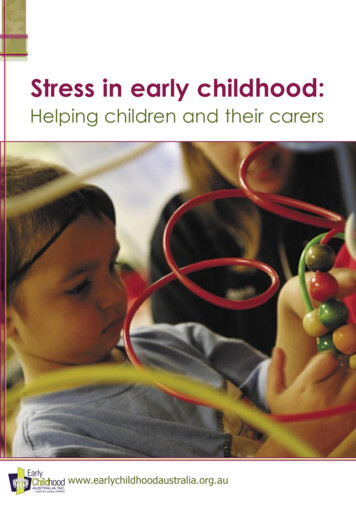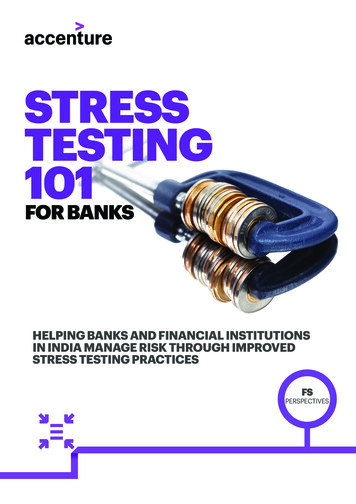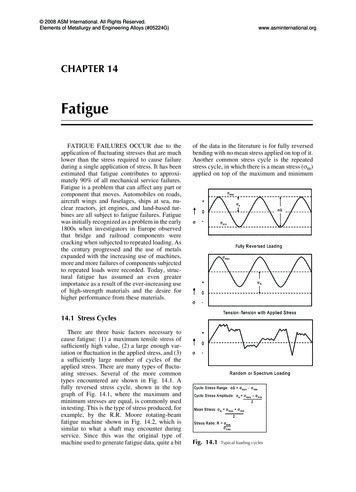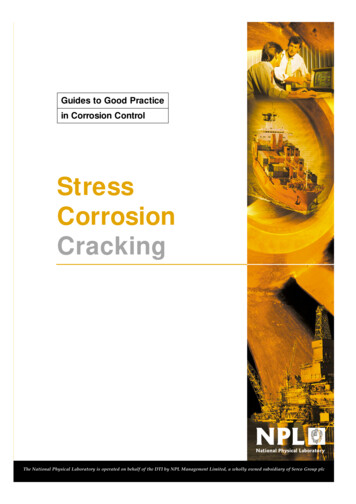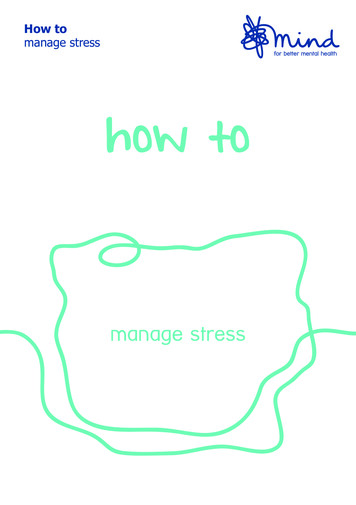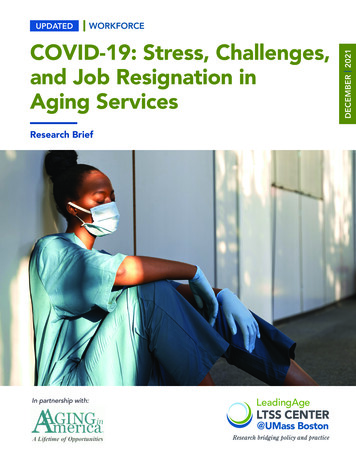
Transcription
WORKFORCECOVID-19: Stress, Challenges,and Job Resignation inAging ServicesResearch BriefIn partnership with:DECEMBER 2021UPDATED
About This ReportThe LeadingAge LTSS Center @UMass Boston would like to thank Aging in America, Inc.,for its generous support of this work.We would also like to thank David Gehm, president & CEO of Wellspring Lutheran Servicesin Flint, MI, and Jon Golm, president of WeCare ConnectTM in Frankenmuth, MI, for theircollaboration with LTSS Center researchers on this study.Authors:Verena Cimarolli and Natasha Bryant, LeadingAge LTSS Center @UMass BostonAbout the LTSS CenterThe LeadingAge LTSS Center @UMass Boston conducts research to help our nation address thechallenges and seize the opportunities associated with a growing older population. LeadingAgeand the University of Massachusetts Boston established the LTSS Center in 2017. We strive toconduct studies and evaluations that will serve as a foundation for government and provideraction to improve quality of care and quality of life for the most vulnerable older Americans.The LTSS Center maintains offices in Washington DC and Boston, MA.For more information, visit LTSSCenter.org.
Table of ContentsOverview.2The Research Study.3Detailed Findings of Both Phases of the Study.5Preparedness and Communications.7Prevalence of Challenges by Setting.8Comparing Stresses Across Settings.8How Can Providers Support Stressed Caregivers?.10Staffing Levels and Workload Demands.11Access to Testing and PPE.11Conclusion.11References.12
OverviewApproximately 4.6 million direct care professionalsin the United States provide life-sustaining careto people who are older, live with disabilities,or have complex medical needs.Professional caregivers include home care aides,home health aides, nursing assistants, andcertified nursing assistants (CNA) working innursing homes, assisted living communities,and in the private homes/apartments whereolder adults live. These caregivers play acritically important role in helping care recipientsremain healthy, maintain their independence,and avoid unnecessary use of expensivehealth care services.Direct care professionals have found themselveson the frontlines of the coronavirus pandemic.From March 2020 to June 2021, the virus infectedover 1.38 million people in 32,000 nursinghomes and other long-term services andsupports (LTSS) settings. At least 184,000coronavirus deaths have been reported amongLTSS residents and staff, accounting for 31%of all COVID-19-related deaths nationwide(The New York Times, 2021).Despite the significant personal risk theyencounter on the job each day, professionalcaregivers often lack access to hazard pay, paidtime off, pandemic-specific training, affordableand accessible childcare, or adequate personalprotective equipment (PPE).Threats to Physical HealthDirect care professionals are particularlysusceptible to contracting COVID-19 and areat increased risk of severe illness if they becomeinfected with the virus. These risks are directlyassociated with several factors.For example, professional caregivers: Have daily exposure to residents and clientswho have been infected with the virus. Live in communities with high COVID-19 rates. Belong to demographic groups—includingpeople of color and older adults—that aremore likely to have comorbidities that canincrease the risk for severe illness and mortalityfrom COVID-19 (Lee et al., 2020; PHI, 2020;True et al., 2020; Gross et al., 2020; Koma etal., 2020; Laurencin and McClinton, 2020). Often use public transportation, which putsthem at higher risk for COVID-19 exposure. Work multiple jobs, which increases theirexposure to COVID-19 and their ability tospread the virus to multiple care settings(PHI, 2020; True et al., 2020; Lee et al., 2020).Threats to Mental HealthThe pandemic negatively affected the mentalhealth of frontline professionals (Kirzinger etal., 2020; Tomlin, Dalgleish-Warburton, andLamph, 2020; Wu et al., 2020). A Kaiser FamilyFoundation study (2021) found that 62% offrontline caregivers, including those working innursing homes, reported that pandemic-relatedworry or stress had a negative impact on theirmental health. Approximately three in 10 directcare professionals received mental health services,or thought they needed these services butdidn’t receive them, because of the pandemic.COVID-19: Stress, Challenges, and Job Resignation in Aging Services2
Workforce ShortagesCOVID-19 intensified and shed new light onexisting workforce shortages in the LTSS field.A survey conducted by the American HealthCare Association and the National Centerfor Assisted Living (2021) found that 99%of nursing homes and 96% of assisted livingcommunities in the U.S. are facing staffingshortages, with 59% of nursing homes andapproximately one-third of assisted livingcommunities experiencing a high level ofstaffing shortages.These staffing shortages have a wide-rangingimpact. They make it more challenging toprovide basic care, monitor residents, andfollow protocols. In addition, shortages resultin even more staff leaving the job (McGiltonet al., 2020).The presence of adequate staffing levels hasthe opposite effect. For example, Gorges andKonetzka (2020) found that nursing homes withone or more COVID cases were more likely tohave fewer deaths and lower probability ofsevere outbreak if they had high nursing assistanthours and a high share of total nursing hoursprovided by registered nurses (RN).Pre-Pandemic ChallengesThe coronavirus pandemic exacerbatedchallenges that direct care professionals havefaced for many years. These caregivers are: Inadequately supported: Many direct careprofessionals lack access to reliable andaffordable transportation and childcare(Famakinwa, 2020).The Research StudyDuring the early days of the coronavirus pandemic,the LeadingAge LTSS Center @UMass Bostonpartnered with WeCare ConnectTM to study theimpact of COVID-19 on LTSS staff working forLeadingAge provider members.WeCare ConnectTM is an employee engagementand management system created by WellspringLutheran Services, a Michigan-based LeadingAgemember. The WeCare ConnectTM system helps165 organizations, with more than 1,200 locationsaround the country, solicit regular feedback fromtheir employees. Employee responses to anonline battery of questions help employers betterunderstand staff challenges with onboarding,training, supervisor relationships, job fit, jobsatisfaction, expectations, and the physical andorganizational environment.During May 2020, WeCare ConnectTM addedseveral pandemic-related questions, createdby LTSS Center researchers, to its employeeinterview battery. This report presents whatLTSS Center researchers learned after analyzingthe responses to those questions from twosamples of employees participating in theWeCare ConnectTM employee interview battery. Undervalued: Most direct care professionalsare women (87%) and people of color (61%),and approximately one-quarter areimmigrants (27%). These professionalcaregivers can face discrimination on the job.In addition, the demands and value of theirwork are often underestimated (PHI, 2021). Financially insecure: In 2020, direct careprofessionals typically earned a medianhourly wage of 13.56. In 2019, 15% ofprofessional caregivers lived in poverty and45% received public benefits (PHI, 2021).COVID-19: Stress, Challenges, and Job Resignation in Aging ServicesMost direct care professionalsare women (87%) andpeople of color (61%), andapproximately one-quarterare immigrants (27%).3
Two Phases of the StudyThe first phase of the LTSS Center research,referred to here as the “multi-setting phase,”examined how 1,414 direct care professionalsresponded to the LTSS Center’s pandemicrelated questions. These direct care professionalsworked in assisted living and independentliving communities, nursing homes, home andcommunity-based services (HCBS) agencies,and health care services. They were employedor had resigned in May 2020.The second phase of the research, referredto here as the “nursing home phase,” examinedhow 1,730 nursing home staff members respondedto the LTSS Center’s pandemic-related questions.Nursing home staff participating in this phase ofthe study included direct care professionals, RNsand licensed practical nurses, staff in dietary andenvironmental services departments, therapists,and social workers. These staff members wereeither still employed (n 1,467) at the endof November 2020 or had resigned (n 263)between June 2020 and the end ofNovember 2020.Research Questions and AimsResearchers sought to answer these questionsduring both phases of the study:1. What specific challenges (external andwork-related) and level of stress are frontlineprofessionals experiencing during thecoronavirus health crisis?2. How do professional caregivers perceivetheir own preparedness to care for residents/patients/clients with COVID-19 and how docaregivers rate the quality of employercommunication around COVID-19?Researchers had additional aims during eachphase of the study. In the multi-setting phaseof the study, researchers focused on whetherthe stresses/challenges and perceptions notedin employee responses to pandemic-relatedquestions differed by setting or amongcurrently employed and resigned employeesin May 2020.In the nursing home phase of the study, researcherscompared the responses of employees whoresigned between May 2020 and the end ofNovember 2020 with responses from employeeswho stayed on the job during that period.Researchers sought to: Identify the differences between nursinghome employees who had resigned andthose who were still employed at thenursing homes. Determine if high-quality employercommunication regarding COVID-19influenced whether professional caregiversat nursing homes decided to remain on thejob, when taking into account such factors asperceived preparedness to care for residentswith COVID-19, length of employment, anddirect caregiver status.COVID-19: Stress, Challenges, and Job Resignation in Aging Services4
Detailed Findings of Both Phases of the StudyChallenges Faced by LTSS StaffExternal ChallengesIn both phases of the study, LTSS staff reported experiencing the same challenges outside of work: Separation from family members. Managing the personal needs and demands of family. Experiencing financial hardship.Resigned direct care professionals in the multi-setting phase of the study experienced externalchallenges more frequently than current employees. A smaller percentage of resigned directcare professionals in this phase (33%) did not report any challenges, compared to currentemployees (39%).External Challenges: Multi-Setting PhasePercentage of Current and Resigned Direct Care 0%11%5%0%Separationfrom gpersonal needsand demandsof familymembersCurrent Employees (n 1,258)COVID-19: Stress, Challenges, and Job Resignation in Aging ServicesLack ofchildcare5%Lack oftransportationNoneResigned Employees (n 103)5
Work-Related ChallengesLTSS staff in both phases of the study reported the same top work-related challenges: Increased workload demands. Increased risk of virus transmission to and from residents or clients. Understaffing.Resigned direct care professionals in the multi-setting phase reported understaffing as a work-relatedchallenge more often than current direct care professionals (43% of resigned versus 33% of currentdirect care professionals). Resigned direct care professionals were also more likely than currentdirect care professionals (18% versus 8%) to identify as a challenge their organizations’ lack ofprotocols or guidance on caring for residents or clients. Approximately 40% of current andresigned direct care professionals across settings did not report any work-related challenges.Work-Related Challenges: Multi-Setting PhasePercentage of Current and Resigned Direct Care 0%21%18%15%18%10%8%5%0%UnderstaffingIncreasedrisk of virustransmissionto/fromresidentsor clientsIncreasedworkloaddemandsCurrent Employees (n 1,258)COVID-19: Stress, Challenges, and Job Resignation in Aging ServicesLack ofPPELack oforganizationalprotocols/guidanceto care forresidents/clientsNoneResigned Employees (n 103)6
Stress LevelsLTSS staff members in the study reported feelingstressed during the pandemic. On average,current direct care professionals in the multi-settingphase of the study rated their stress level in May2020 at 2.9 on a scale from 1 to 5, with 5 beingthe most stressed. Direct care professionals inthe multi-setting phase of the study who wereresigned in May 2020 reported a higher level ofstress, with an average rating of 3.3.In comparison, current and resigned employeesin the nursing home phase of the study ratedtheir overall stress level during the pandemic at2.8 in May 2020.Resigned vs. Current Employees Preparing them to care for residents,patients, or clients with COVID-19.During the nursing home phase of the study,current nursing home employees gave theiremployers higher scores for quality ofcommunication than resigned nursing homeemployees. Current nursing home employeesalso rated their own preparedness higher thanresigned nursing home employees. Lower ratingsfrom resigned nursing home employees affectedthe likelihood of their resignation. Data from thenursing home phase of the study (Cimarolli et al.,2021) suggest that: Communicating with them about how tocare for and protect residents, patients,or clients and how to protect themselvesand their family members during thepandemic. Employees were more likely to feel preparedif the employer provided high-qualitycommunication on how to care for residentsor patients and how staff could protectthemselves and their family members.Preparedness and CommunicationsIn both phases of the study, LTSS staff reportedthat their employers adequately preparedthem to care for residents/patients/clients withCOVID-19. On average, participants in bothphases of the study gave their employersa high score of 4, on a scale of 1 to 5, for:Employees who feltmore prepared due tohigh-quality communicationwere less likely to resignfrom their job.COVID-19: Experiences of Direct Care Workers in Aging Services Employees who felt more prepared due tohigh-quality communication were less likelyto resign from their job.7
Prevalence of Challengesby SettingThe multi-setting phase of the study comparedthe challenges of direct care professionals acrosssettings in May 2020. Here are those findings:Nursing HomesSeparation from family members was the topexternal challenge reported by direct careprofessionals in nursing homes. Understaffing wasthe top work-related challenge. Approximatelyfour in 10 nursing home caregivers did not reportany work-related or external challenges.Assisted LivingSeparation from family members topped the listof external challenges identified by direct careprofessionals in assisted living communities.Understaffing topped the list of work-relatedchallenges. About 40% of direct care professionalsin assisted living did not report any work-relatedor external challenges.HCBSFinancial hardship was the top external challengereported by HCBS direct care professionals.Increased risk of virus transmission to or fromclients was the top work-related challengereported by these caregivers. More than halfof HCBS direct care professionals did not reportany work-related challenges and one-third didnot report any external challenges.More than a third (37%) ofnursing home direct careprofessionals and 33% ofprofessional caregivers inassisted living communitiesreported understaffingas a challenge.COVID-19: Experiences of Direct Care Workers in Aging ServicesComparing Stresses Across SettingsDirect care professionals in nursing homes andassisted living communities were statisticallymore likely than HCBS direct care professionalsto report increased workload demands andunderstaffing as challenges. Specifically:Increased WorkloadNearly a quarter (24%) of nursing home andassisted living direct care professionals reportedincreased workload as a challenge, comparedto 10% of direct care professionals in HCBSagencies.UnderstaffingMore than a third (37%) of nursing home directcare professionals and 33% of professionalcaregivers in assisted living communities reportedunderstaffing as a challenge, compared to 13%of professional caregivers in HCBS agencies.StressDirect care professionals in all three settingshad similar levels of stress, with an averagerating of 3 on a scale of 1 to 5.8
External Challenges by Setting: Multi-Setting PhasePercentage of Direct Care Workers50%45%41%40%35%38%37%33% 5%0%5%4%Separation fromfamily membersManaging thepersonal needsand demandsof familyExperiencingfinancial hardshipsAssisted Living (n 186)Lack ofchildcareLack oftransportationHCBS (n 167)NoneNursing Home (n 675)Work-Related Challenges by Setting: Multi-Setting PhasePercentage of Direct Care Workers70%60%54%50%43%40%33%30%20%29% 26%20%24%19%13%10%10%0%24%12%17%9%4%Increased risk ofvirus transmissionto/from residentsor Assisted Living (n 182)Lack of PPEHCBS (n 163)COVID-19: Stress, Challenges, and Job Resignation in Aging Services8%Lack of organizationalprotocols/guidanceto care forresidents/clientsNoneNursing Home (n 672)9
How Can Providers SupportStressed Caregivers?Both phases of this study provided practicalinsights into how providers of aging servicescan support direct care professionals duringhealth emergencies like the coronaviruspandemic. This support could enhance thedelivery of high-quality care for residentsand clients who receive LTSS and couldstrengthen the direct care workforce(McGilton et al., 2020).Communication and PreparationLeaders in all LTSS settings should train staff oninfection control and how to care for residentsor patients during the pandemic. Organizationsshould also provide timely communication andshould be as transparent as possible regarding: Organizational policy changes.Safety protocols and procedures.State of the organization.How to protect oneself and others.Employers could consider utilizing daily huddlesto provide staff with updates and addressconcerns. Messaging platforms can also helpemployers provide guidelines and post helpfulresources for staff (McGilton et al., 2020).Valuing Direct Care ProfessionalsOver the long term, LTSS organizations shouldtake deliberate steps to professionalize andraise the value of LTSS direct care professionals.Policies and strategies that can elevate the roleand improve the recruitment and retention ofdirect care professionals include: Developing higher entry-level and ongoingtraining standards. Preparing individuals to work across all LTSSsettings as universal workers (Stone andBryant, 2021).Wrap-Around ServicesDirect care professionals experience difficultiesmanaging family needs and financial hardship.Providers can help mitigate these stresses byproviding access to wrap-around services,including:Food delivery and laundry services.Financial education.Mental well-being support.Childcare support.Emergency financial assistance.Access to transportation.Information about public benefits andcommunity services. Referrals to help address specific challenges. Mental Well-BeingProviders of aging services can build the capacityof staff members to address pandemic-relatedchallenges by supporting employees’ mentalwell-being. This support could include offeringprofessional caregivers access to: Individual counseling. Team member support groups. Mental health resources offered throughpartnerships with community organizations. De-stress rooms featuring quiet music. Increasing the pay of direct care professionalsto a living wage. Providing direct care professionals withaccess to benefits. Creating career pathways for both lateraland vertical career mobility.COVID-19: Stress, Challenges, and Job Resignation in Aging ServicesLeaders in all LTSS settingsshould train staff on infectioncontrol and how to care forresidents or patients duringthe pandemic.10
Tips for how staff can take short breaksfrom stress. Relevant articles that normalize the emotionspeople may be experiencing. These articlescould be included in the organization’semployee newsletter or posted on abulletin board. Activities that cultivate a spirit of funand camaraderie.Staffing Levels andWorkload DemandsProviders of aging services cannot assume thatissues relating to understaffing and workloaddemands will disappear in the near future. Instead,providers should take immediate action to increasetheir staffing levels by taking these steps:ConclusionThis study sheds light on the external andwork-related challenges that direct careprofessionals and other LTSS staff haveexperienced during the COVID-19 pandemic.Study findings suggest that providers can helpmitigate some of the stress that professionalcaregivers feel by offering wrap-around servicesand support for mental well-being, increasing thecaregiver pipeline to reduce understaffing andheavy workloads, and finding ways to reducethe demands on professional caregivers duringthe coronavirus pandemic and during futurehealth emergencies.Strengthening the Caregiver PipelineThis can be accomplished by training newcohorts of professional caregivers to fill vacantpositions.Creating Flexible and CreativeWork SchedulesHome care agencies may: Negotiate revised schedules with clients. Cluster cases together to minimize travel time. Temporarily reduce client hours when it issafe to do so.Nursing homes and other residential careproviders may also stagger shifts and allowstaff to work different shifts than usual.Access to Testing and PPEThe shortages of testing and PPE have beenwidely acknowledged since the pandemicbegan. Providers of aging services must dowhatever they can to: Give staff members access to these tools. Adopt policies addressing infection controland treatment. Train staff in implementing those policies.COVID-19: Stress, Challenges, and Job Resignation in Aging ServicesStudy findings suggestthat providers can helpmitigate some of thestress that professionalcaregivers feel byoffering wrap-aroundservices and supportfor mental well-being;11
ReferencesAmerican Health Care Association andNational Center for Assisted Living. (2021).State of the Long-Term Care Industry: Survey of nursinghome and assisted living providers show industry facingsignificant workforce crisis. Retrieved from: 21.pdfCimarolli, V.R., Bryant, N.S., Falzarano, F.,and Stone, R. (2021).Job Resignation in Nursing Homes During theCOVID-19 Pandemic: The Role of Quality of EmployerCommunication. Journal of Applied Gerontology,07334648211040509.Famakinwa, J. (2020).Coronavirus worsening workforce challenges for manyin-home caregivers. Home Health Care News. aregivers/Gorges, R.J. and Konetzka, R.T. (2020).Staffing levels and COVID-19 cases and outbreaksin U.S. nursing homes. Journal of the AmericanGeriatrics Society. 832/Gross, C.P., Essien, U.R., Pasha, S., Gross,J.R., Wang, S.Y., and Nunez-Smith, M. (2020).Racial and Ethnic Disparities in Population LevelCovid-19 Mortality. Journal of General InternalMedicine. 35:3097-3099. https://doi.org/10.1101/2020.05.07.20094250Kaiser Family Foundation. (2021).KFF/Post Survey Reveals the Serious Mental HealthChallenges Facing Frontline Health Care Workersa Year into the COVID-19 ger, A., Kearney, A., Hamel, L., andBrodie, M. (2020).KFF/The Washington Post Frontline Health Care WorkersSurvey. Kaiser Family Foundation.Koma, W., Artiga, S., Neuman, T., Claxton, G.,Rae, M., Kates, J., and Michaud, J. (2020).Low-income and communities of color at higher riskof serious illness if infected with coronavirus.KFF May 7, 2020.Laurencin, C.T. and McClinton, A. (2020).The COVID-19 pandemic: A call to action to identify andaddress racial and ethnic disparities. Journal of Racialand Ethnic Health Disparities, 1-5.https://doi.org/10.1007/s40615-020-00756-0Lee, C., Podury, A., Kaduthodil, J., andGraham, L. (2020). Long-term care facilities mustprioritize immigrant workers’ needs to containCOVID-19. Health Affairs Blog. 0914.520181/full/McGilton, K.S., Escrig-Pinol, A., Gordon, A., Noguchi-Watanabe, M., Wang, J., and Bowers, B. (2020).Uncovering the Devaluation of Nursing Home Staffduring COVID-19: Are We Fueling the Next Health CareCrisis? JAMDA, 21, (7): 962-965. 21/PHI. (2020). It’s time to care: A detailed profile ofAmerica’s direct care workforce. PHI: Bronx, NY. ce/.PHI. (2021). PHI Workforce Data Center. ata-center/Stone, R.I. and Bryant, N. (2021).Feeling valued because they are valued: A vision forprofessionalizing the caregiving workforce in the fieldof long-term services and supports. ploads/2021/07/Workforce-Vision-Paper FINAL.pdfThe New York Times. (2021).Nearly one-third of U.S. coronavirus deaths are linkedto nursing homes. The New York Times, June navirus-nursing-homes.htmlCOVID-19: Stress, Challenges, and Job Resignation in Aging Services12
ReferencesTomlin, J., Dalgleish-Warburton, B., Lapmh, G. (2020).Psychosocial support for healthcare workers during theCOVID-19 pandemic. Frontiers in es/PMC7431467/.True, S., Cubanski, J., Garfield, R., Rae, M., Claxton, G.,Chidambaram, P., and Oregera, K. (2020). COVID-19and workers at risk: Examining the long-term care workforce. KFF. term-care-workforce/Wu, A.W., Buckle, P., Haut, E.R., Bellandi, T., Koizumi,S., Mair, A., . and Vincent, C. (2020).Supporting the emotional well-being of health careworkers during the COVID-19 pandemic. Journal of PatientSafety and Risk Management. EPub ahead of VID-19: Stress, Challenges, and Job Resignation in Aging Services13
WASHINGTON, DC OFFICE2519 Connecticut Avenue NWWashington, DC 20008202-508-1208LTSScenter@leadingage.orgBOSTON OFFICEWheatley Hall, 3rd Floor, Room 124AUniversity of Massachusetts Boston100 Morrissey Blvd.Boston, MA 02125617-287-7324LTSScenter@umb.eduVisit www.LTSSCenter.org to learn more.
for Assisted Living (2021) found that 99% of nursing homes and 96% of assisted living communities in the U.S. are facing staffing shortages, with 59% of nursing homes and approximately one-third of assisted living communities experiencing a high level of staffing shortages. These staffing shortages have a wide-ranging impact.
